The Lowdown on Rainwater Tanks
Here's what you need to know
Darren Clancy
27 September 2015
Houzz Australia Contributor. Owner of Pipe Perfection Plumbers with over 30 years’ industry experience.
Houzz Australia Contributor. Owner of Pipe Perfection Plumbers with over 30 years’... More
The attitude towards harvesting rainwater has changed dramatically over the last few years. With the weather swinging from drought to ‘storm of the century’, and the increase in awareness of how we can live sustainably and preserve our precious resources, there has been a resurgence in the use of rainwater tanks in urban and suburban areas. Here’s the lowdown on installing rainwater tanks and how they can help you save money.
Do your bit for the environment
Rainwater or ‘detention tanks’ store the water that is collected from a building’s roof during a storm. The harvested water can be used to reduce mains water usage on a property by supplying water for some, if not all, household needs, minimising our dependence on mains water and helping safeguard this precious resource. Rainwater harvesting also helps reduce the damage to our creeks, rivers and oceans caused by heavy stormwater runoff. Therefore, harvesting rainwater is a great way to make a positive impact on your garden, home and local environment.
Rainwater or ‘detention tanks’ store the water that is collected from a building’s roof during a storm. The harvested water can be used to reduce mains water usage on a property by supplying water for some, if not all, household needs, minimising our dependence on mains water and helping safeguard this precious resource. Rainwater harvesting also helps reduce the damage to our creeks, rivers and oceans caused by heavy stormwater runoff. Therefore, harvesting rainwater is a great way to make a positive impact on your garden, home and local environment.
It all adds up
At the very least, harvested rainwater can be used for watering the garden and washing the car. If a licensed plumber installs your tank, they can also connect it to supply your toilet and washing machine. Then the water (and money) savings will really start to add up, as it has been estimated that garden watering and toilet flushing account for as much as half the water we expend. By lowering your water usage, you may even qualify for rebates from some councils.
At the very least, harvested rainwater can be used for watering the garden and washing the car. If a licensed plumber installs your tank, they can also connect it to supply your toilet and washing machine. Then the water (and money) savings will really start to add up, as it has been estimated that garden watering and toilet flushing account for as much as half the water we expend. By lowering your water usage, you may even qualify for rebates from some councils.
Can everyone have a tank?
Any homeowner can choose to install a tank, but each local council and water authority tends to have its own regulations. A development or building application may be required, and there are rules around drinking rainwater, backflow and mosquito breeding prevention to adhere to. You may also find regulations on the tank’s colour, height and location, and the noise generated from the pump. Those building from scratch or undergoing a huge renovation should also be aware that certain energy- and water-efficient features may also be required.
Any homeowner can choose to install a tank, but each local council and water authority tends to have its own regulations. A development or building application may be required, and there are rules around drinking rainwater, backflow and mosquito breeding prevention to adhere to. You may also find regulations on the tank’s colour, height and location, and the noise generated from the pump. Those building from scratch or undergoing a huge renovation should also be aware that certain energy- and water-efficient features may also be required.
Where to put your tank
The tank’s location is a key determinant of its size, shape, material and even it’s colour, especially if you decide to blend it in with surroundings.
In many cases, installing a tank above ground and alongside your dwelling makes the most sense. However, underground tanks can also be a great solution if you are limited on space or live in an urban location. Your options could be along the fence, under a deck, in the sub floor, underground, as a retaining wall, tucked next to the house or in the backyard.
Another option is in a high spot (as pictured left), so it can be gravity-fed, thereby avoiding the noise, maintenance and energy needs of a pump.
The best place for it, however, is in a shaded spot, to keep water temperature low, reduce evaporation and slow down deterioration.
The tank’s location is a key determinant of its size, shape, material and even it’s colour, especially if you decide to blend it in with surroundings.
In many cases, installing a tank above ground and alongside your dwelling makes the most sense. However, underground tanks can also be a great solution if you are limited on space or live in an urban location. Your options could be along the fence, under a deck, in the sub floor, underground, as a retaining wall, tucked next to the house or in the backyard.
Another option is in a high spot (as pictured left), so it can be gravity-fed, thereby avoiding the noise, maintenance and energy needs of a pump.
The best place for it, however, is in a shaded spot, to keep water temperature low, reduce evaporation and slow down deterioration.
Size
The space you have available, household and garden size, along with planned usage, will all have a bearing on the size of tank you choose.
Essentially, all you will need to consider is the space you have or the location of your intended water storage tank, the rainfall in your area, the size of your roof (or catchment surface in trade speak) and your water usage or how much you expect you will use the harvested water.
When working out the size of which tank you will need, the Tankulator is a great online calculator from the Alternative Technology Association that even takes into account the rainfall in your area.
The space you have available, household and garden size, along with planned usage, will all have a bearing on the size of tank you choose.
Essentially, all you will need to consider is the space you have or the location of your intended water storage tank, the rainfall in your area, the size of your roof (or catchment surface in trade speak) and your water usage or how much you expect you will use the harvested water.
When working out the size of which tank you will need, the Tankulator is a great online calculator from the Alternative Technology Association that even takes into account the rainfall in your area.
Materials
The material of the tank will directly relate to its durability:
The material of the tank will directly relate to its durability:
- Concrete tanks are ideal as an in-ground solution under garages and driveways as they have load-bearing lids
- Steel tanks are extremely strong with polyethylene tank lining to prevent corrosion and ensure water quality
- Plastic or poly tanks come in a variety of shapes, colours and sizes and are lightweight and easy to install
- Fibreglass tanks, while expensive, are a long-lasting option that is corrosion-resistant and sturdy
Bladders and modular rainwater storage options are also now available on the market and are great where space is an issue, such as in urban areas.
Now, which tank?
Location, size and materials will largely influence your final choice of tank. Here are three more factors to consider:
Location, size and materials will largely influence your final choice of tank. Here are three more factors to consider:
- The surface you have available and if it needs to be prepared/cleared before installation
- The durability of each tank’s material with respect to its proposed location and the surrounding environment
- Whether the tank can be installed above or under the ground
Retention tanks
Trends in urban expansion have resulted in an increase in run off from hard surfaces such as parking, driveways and paved areas, requiring better drainage in the infrastructure of certain areas. As part of this trend, some councils require a retention tank be incorporated on a property.
A stormwater retention tank is designed to sit empty and then fill during storms. It then slowly releases water into the municipal drains. It holds back then slowly releases the water from your property. This is quite different to a traditional rainwater (or detention) tank, which simply stores the stormwater for domestic use.
Usually councils have fairly specific requirements for retention tank installation, particularly in new developments, so it is important to always check with your local council first. Any details of an on-site stormwater retention system will need to be assessed as part of a dwelling’s planning consent application.
Trends in urban expansion have resulted in an increase in run off from hard surfaces such as parking, driveways and paved areas, requiring better drainage in the infrastructure of certain areas. As part of this trend, some councils require a retention tank be incorporated on a property.
A stormwater retention tank is designed to sit empty and then fill during storms. It then slowly releases water into the municipal drains. It holds back then slowly releases the water from your property. This is quite different to a traditional rainwater (or detention) tank, which simply stores the stormwater for domestic use.
Usually councils have fairly specific requirements for retention tank installation, particularly in new developments, so it is important to always check with your local council first. Any details of an on-site stormwater retention system will need to be assessed as part of a dwelling’s planning consent application.
But wait, there’s more…
Once you have decided on a tank and looked into your local council requirements for regulations, choice and installation, do take the time to factor in other potential costs such as pumps, site preparation (sand/concrete pads or a stand), delivery, pipework, fittings, taps, first flush devices, installation and, if connecting to mains water, backflow prevention.
These will incur added costs but if you have a clear idea of the system you are after, you will be able to work out a very good estimate of cost.
TELL US
Do you have a rainwater tank? What do you see as the benefits? Let us know in the Comments.
MORE
20 Questions to Ask Before Installing a Water Tank
Eco-Conscious Australian Homeowners Open Their Doors
11 Ways to Save Water (and a Little Money While You’re at It) at Home
Once you have decided on a tank and looked into your local council requirements for regulations, choice and installation, do take the time to factor in other potential costs such as pumps, site preparation (sand/concrete pads or a stand), delivery, pipework, fittings, taps, first flush devices, installation and, if connecting to mains water, backflow prevention.
These will incur added costs but if you have a clear idea of the system you are after, you will be able to work out a very good estimate of cost.
TELL US
Do you have a rainwater tank? What do you see as the benefits? Let us know in the Comments.
MORE
20 Questions to Ask Before Installing a Water Tank
Eco-Conscious Australian Homeowners Open Their Doors
11 Ways to Save Water (and a Little Money While You’re at It) at Home
Related Stories
Garden Design
Cheap Tricks to Landscape Your Garden Without Spending the Earth
Use simple landscaping devices in your backyard to create maximum impact with minimum spend
Full Story
From The Pros
What a Landscape Architect Really Does
Is a landscape architect the best for your home's surrounds? Finding out what they're all about is the first step to take
Full Story
Most Popular
Good Neighbours: How to Stop Your Outdoor Noise Travelling
From rugs and awnings to screens, here are some noise-dampening ideas to keep you in your neighbours' good books
Full Story
Most Popular
Spend & Save: Where to Put Your Money When Planning Your Outdoors
US pros reveal where to spend money for long-lasting benefits and cost savings when redesigning your outdoor space
Full Story
Most Popular
5 Steps to Finding the Right Landscape Designer for Your Home
If you dream of a green retreat but your reality is more backyard bungle, knowing how to choose a landscaper is key
Full Story
Gardening
Top 10 Things to Do in the Garden in June
Plenty of planting can be done in the garden this month as autumn sets in, though watch out for snails and mould
Full Story
Gardening
Top 10 Things to Do in the Garden in May
There’s still plenty to do in the garden as we head towards winter, here's a list of easy tasks for autumn
Full Story
Pools
So How Much Does a Pool (Really) Cost?
Dreaming of a pool for your backyard but unsure what it will set you back? We have the answers
Full Story
Garden Design
7 Landscape Design Ideas to Replace Your Lawn
Consider a design that welcomes wildlife, requires less maintenance, encourages gathering and better suit your needs
Full Story
Outdoor Areas
Fine Time: Take a Moment to Enjoy the Most Popular Decks of 2022
Is there any greater feeling than taking a few steps outside your home to enjoy sun, fresh air and birdsong?
Full Story



















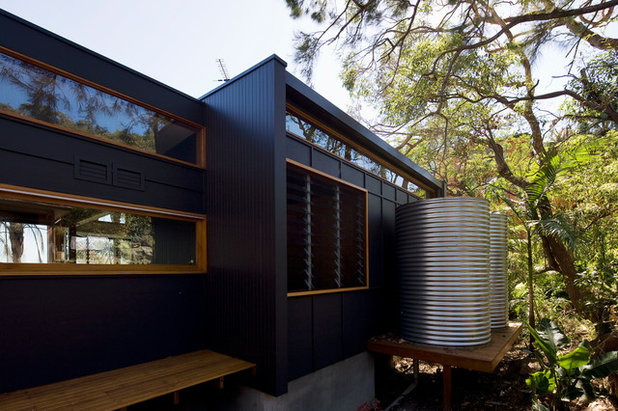
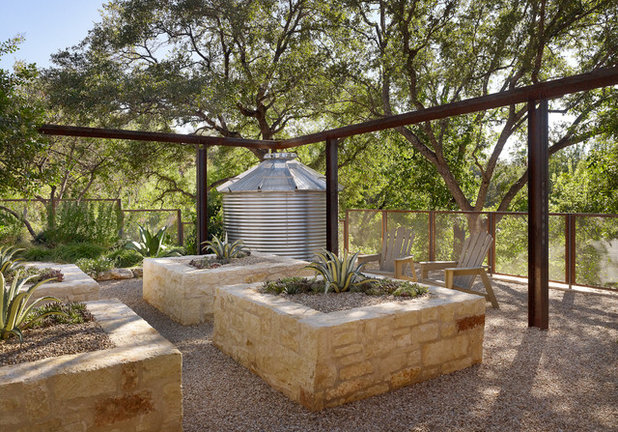
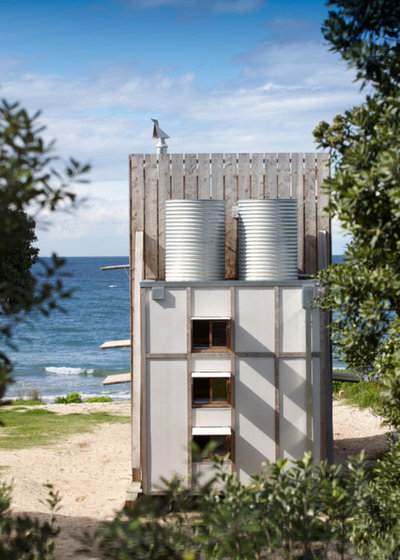
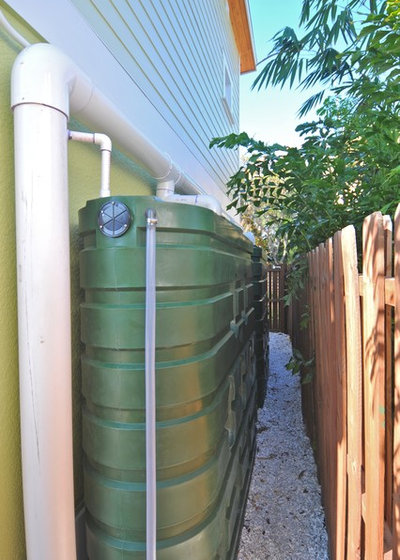


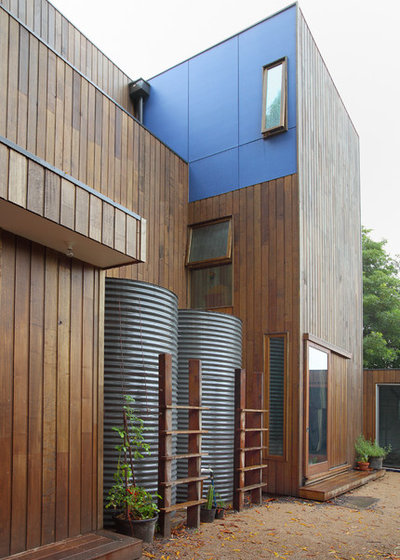













With footprint for a tank a problem, I once considered bags that I could install under the back deck - I'm not knocking the deck down to install a tank!
Does anyone have any information on large volume water storage bags? They are used in the military to store fuel; I am aware they are used to store avgas to service aircraft using temporary airstrips. Are they used for water? What materials are non-perishable? What are the specs for safe installation - I am on a sloping block and would need to get a shelf cut into the ground (on hands and knees!!). Does the dead weight make them stable, or would I need some kind of a (low) retaining wall?
Or is there a tank - or tanks - that might work in a space about 750mm high?
Advice appreciated.
We're lucky to live where we do, there's no industry or heavy traffic within a hundred km and a fresh seabreeze most days clears the air. We harvest our rainwater from the shed roof which is then plumbed via gravity to my kitchen where I have a dedicated drinking/cooking tap (the scheme water tastes disgusting and is used only for cleaning). The rain water is sweet, clear, clean, delightful. We go months without rain here (summer) so disconnect the pipes before the first rains come and clean off the shed roof and gutters.
I was really interested with the Hydrowall concept, would love to talk to anyone using it: http://www.superwall.com.au/hydrowall-modular-wall-systems
Here's an upside to having a rainwater tank! These guys are Brilliant to deal with, just book your tank cleaning online here at https://sydneytankcleaning.com.au/